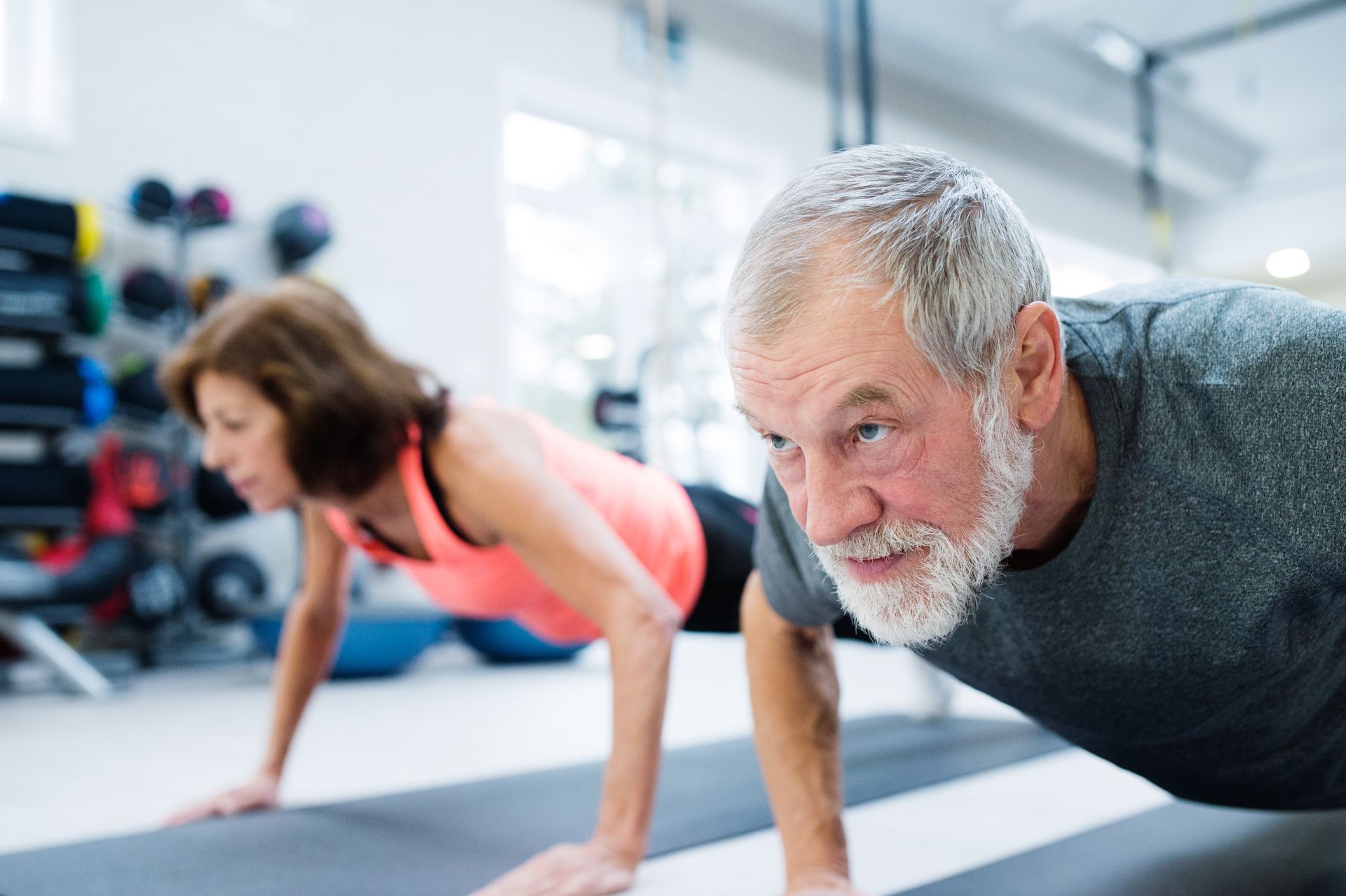BLOGS
Blogs

By Jessica Ellett
•
November 5, 2024
Menopause marks a significant change in a woman’s life, often beginning with a transitional phase called perimenopause, during which hormone levels begin to fluctuate. This hormonal shift can lead to a range of symptoms, from mild to severe, affecting physical, emotional, and mental health. Hormone Replacement Therapy (HRT) has emerged as a popular treatment for alleviating menopausal symptoms and improving quality of life for many women during this transition. Here, we'll explore how HRT can help women as they enter perimenopause and menopause. 1. What Is Hormone Replacement Therapy? Hormone Replacement Therapy involves supplementing the body with hormones that are naturally decreasing due to menopause, primarily estrogen and progesterone. HRT can be administered through various methods, including oral tablets, patches, gels, and creams. Some women receive combined HRT (estrogen and progesterone) if they still have their uterus, while others who have had a hysterectomy may use estrogen-only HRT. For women in perimenopause, low-dose HRT may be used to ease the transition and manage initial symptoms. 2. Relief from Common Menopausal Symptoms Hormone fluctuations in perimenopause and menopause can lead to symptoms such as hot flashes, night sweats, mood swings, sleep disturbances, and vaginal dryness. HRT can alleviate many of these symptoms by restoring hormone levels. Here’s a look at some specific benefits: Reduction in Hot Flashes and Night Sweats: Estrogen is one of the primary hormones that regulate body temperature. As levels decline, women often experience sudden, intense waves of heat (hot flashes) and night sweats. HRT helps reduce the frequency and severity of these episodes, allowing for better comfort during the day and more restful sleep at night. Mood Stability and Mental Health: Mood swings and emotional instability can be challenging during perimenopause. Estrogen has been shown to have a positive effect on mood by influencing serotonin, a brain chemical responsible for regulating mood. HRT can help stabilize emotions, reducing the likelihood of mood swings, irritability, and anxiety. Improved Sleep Quality: Alongside night sweats, the hormonal fluctuations of menopause can disrupt normal sleep cycles, leading to insomnia or difficulty staying asleep. By stabilizing hormone levels, HRT can make it easier to fall and stay asleep, significantly improving overall well-being and daily energy levels. Relief from Vaginal Dryness and Discomfort: Estrogen is essential for maintaining the elasticity and lubrication of vaginal tissues. With its decline, many women experience dryness, irritation, and discomfort during intercourse. HRT, especially in the form of localized creams or rings, can provide relief, enhancing comfort and intimacy. 3. Long-Term Health Benefits of HRT Beyond alleviating immediate symptoms, HRT may also have long-term health benefits, though these can vary based on individual health profiles. Research has shown that HRT may contribute to: Bone Health: Estrogen plays a key role in maintaining bone density. As levels decrease during menopause, women face an increased risk of osteoporosis. HRT has been shown to slow bone loss, which can reduce the risk of fractures and osteoporosis, keeping women more active and mobile as they age. Cardiovascular Health: There’s evidence that HRT may benefit heart health, as estrogen has a positive effect on cholesterol levels and vascular function. However, the connection between HRT and heart disease prevention is complex and varies by individual, so it’s essential to discuss personal risk factors with a healthcare provider. 4. Addressing Concerns About HRT and Safety For years, HRT was controversial due to concerns about its association with certain cancers and cardiovascular risks. However, studies now show that the timing and duration of HRT are key factors in its safety and effectiveness. Generally, starting HRT before age 60 or within 10 years of menopause onset has shown fewer risks and more pronounced benefits. Modern HRT formulations and individualized treatment plans allow women to manage their symptoms effectively while minimizing potential risks. It’s crucial to approach HRT with the guidance of a healthcare provider who can assess personal health history, weigh potential risks and benefits, and determine the most suitable type and dosage. With regular check-ups and an individualized plan, many women can use HRT safely and effectively to manage menopausal symptoms. 5. Considering Alternatives to HRT HRT isn’t the only option for managing menopausal symptoms, and some women may prefer or need alternatives. Lifestyle adjustments—such as dietary changes, regular exercise, and stress management—can complement HRT or serve as standalone methods for symptom relief. Additionally, herbal supplements, acupuncture, and cognitive-behavioral therapy have shown benefits for some women. If HRT isn’t an option due to health reasons, these alternatives can still provide significant relief. 6. Deciding If HRT Is Right for You Menopause affects each woman differently, and HRT is not a one-size-fits-all solution. Deciding whether to pursue HRT requires consideration of personal symptoms, medical history, family history, and lifestyle. Consulting with a qualified healthcare provider is essential to create a balanced approach that aligns with your individual needs and goals. Perimenopause and menopause are natural life stages, yet the symptoms can be disruptive to a woman’s daily life and well-being. HRT offers a viable option for many women to manage these changes more comfortably, providing both immediate relief from symptoms and potential long-term health benefits. When used responsibly under medical supervision, HRT can be a powerful tool in helping women navigate this transition with greater ease, health, and quality of life.

By Jessica Ellett
•
November 5, 2024
When it comes to fitness, a one-size-fits-all approach doesn’t necessarily apply, especially when we consider the different physiological and hormonal differences between women and men. These factors impact how each group may respond to certain types of exercises and how they should structure their workouts to achieve the best results. Here’s a breakdown of some key differences and insights on how women and men can work out for optimal fitness outcomes. 1. Hormonal Differences and Their Impact on Training For Women: Women naturally have lower testosterone levels than men, which affects muscle-building potential and recovery time. However, they have higher estrogen levels, which has been shown to contribute to muscle endurance. Women can often benefit from slightly higher rep ranges and shorter rest periods in their routines because they can recover more quickly between sets, especially when it comes to lower body exercises. For Men: With higher testosterone levels, men are generally able to build muscle mass more quickly and may focus on heavier weights with longer rest periods to allow for muscle recovery and growth. Men might find it effective to incorporate exercises with lower reps but higher weight, which stimulates muscle growth efficiently. 2. Body Composition and Muscle Distribution For Women: Women typically have a higher body fat percentage and tend to carry more muscle and fat around their lower bodies. This natural structure makes workouts that emphasize glutes, hips, and thighs more appealing, often aiming for toning, strengthening, and shaping these areas. Women might find routines with exercises like lunges, squats, and deadlifts especially beneficial. For Men: Men usually have a higher percentage of muscle in the upper body, so upper body workouts may yield faster visible results. Men often focus on compound movements like bench presses, pull-ups, and rows, which build chest, back, and shoulder muscles. Upper body strength often comes naturally to men, so their routines may place extra emphasis on upper-body exercises. 3. Strength Training vs. Cardio Balance For Women: Many women prefer a balance of cardio and strength training to support fat loss while preserving muscle. Women’s routines frequently integrate both types, but the focus is usually on steady-state cardio, HIIT (High-Intensity Interval Training), and moderate weight lifting. Strength training with lighter weights and higher reps is popular because it promotes muscle endurance without building excessive bulk. For Men: While cardio is important for overall health, men generally dedicate more time to resistance training. This is partly due to the natural advantage in muscle growth from testosterone and also due to the specific body composition goals many men pursue. Men’s workouts typically prioritize strength-building over cardio, with heavy weights and lower reps often being the preferred approach. However, short HIIT sessions are often added for cardiovascular fitness and fat-burning. 4. Workout Goals: Toning vs. Building Muscle For Women: Common goals among women include building a lean, toned physique without necessarily focusing on increasing muscle size. Women might prefer exercises that use moderate weights, resistance bands, or body weight. Circuit training, Pilates, and yoga are also popular choices, as they offer toning and core-strengthening benefits. For Men: Men often aim to increase overall muscle size and definition, focusing on progressive overload (gradually increasing the weight) to maximize muscle hypertrophy. Building and defining muscle is the central goal for many men’s routines, making powerlifting and bodybuilding techniques more common in men’s workouts. 5. Core Training and Flexibility For Women: Core stability and flexibility are often emphasized in women’s routines, as they help improve posture, protect the lower back, and provide balance. Women tend to gravitate toward yoga, Pilates, and dynamic stretching for flexibility. Exercises like planks, side planks, and leg raises are favorites for core training, with many women incorporating these into their weekly workouts. For Men: Men also benefit from core training, but they may not emphasize flexibility as much as women. Traditional core exercises like crunches, leg lifts, and cable-based ab workouts are popular choices. Men might incorporate mobility training primarily as a supplement to aid in lifting form and injury prevention, with dynamic stretches and foam rolling as pre-and post-workout routines. 6. Focus on Injury Prevention and Recovery For Women: Due to differences in joint structure and a higher tendency toward ACL injuries, particularly in the knees, women often benefit from exercises that promote joint stability and balance. Exercises that strengthen the hip abductors, glutes, and core are important for protecting joints. Women also tend to prioritize low-impact exercises to protect joints and prevent overuse injuries. For Men: Men generally need to prioritize shoulder stability, as the combination of bench presses, shoulder presses, and heavy upper-body lifting can increase the risk of shoulder injuries. Men benefit from exercises that strengthen rotator cuff muscles and incorporate mobility work to prevent tightness. Active rest days are essential for allowing the muscles to recover after heavy lifting. 7. The Importance of Customization and Listening to Your Body While there are some physiological differences that shape how men and women approach their workouts, everyone’s body is unique, and the best workout plan is one that feels sustainable and enjoyable. Women and men alike should customize their routines to meet their individual goals, fitness levels, and preferences, which might mean adjusting traditional gender-based approaches. Ultimately, the best workout isn’t about gender but rather about finding the right balance and adapting to what works best for each individual. By understanding the general physiological differences, men and women can tailor their workouts more effectively, focusing on their specific strengths and areas that may require extra attention. Whether it’s through strength training, cardio, flexibility exercises, or a combination of all three, the goal is a well-rounded routine that supports health, fitness, and personal goals.

By Jessica Ellett
•
October 29, 2024
Here’s how a combination of weight training and consistent exercise support both physical health and your overall quality of life: 1. Maintaining Bone Density and Reducing Osteoporosis Risk As women age, the risk of osteoporosis increases, especially post-menopause. Weight-bearing exercises, including weight training, help maintain and even increase bone density, reducing the risk of fractures and osteoporosis. 2. Preserving Muscle Mass and Strength Muscle mass naturally decreases with age, which can lead to a slower metabolism and reduced strength. Strength training helps preserve and build muscle, making daily activities easier and improving balance, which can reduce fall risk. 3. Boosting Metabolism and Supporting Healthy Weight Management Muscle burns more calories at rest than fat, so maintaining or building muscle helps keep metabolism high, which is beneficial for managing weight and preventing age-related weight gain. 4. Enhancing Joint Health and Reducing Pain Strengthening the muscles around joints can provide added support, reducing stress on the joints and potentially alleviating chronic pain, like arthritis symptoms, which are common as women age. 5. Improving Mental Health and Combating Depression Exercise releases endorphins, which can boost mood and combat anxiety and depression. Regular physical activity also improves cognitive function, which can be especially important in preventing age-related mental decline. 6. Supporting Cardiovascular Health Strength training can improve blood pressure, cholesterol levels, and overall heart health, reducing the risk of cardiovascular disease, which is a leading cause of death in older women. 7. Increasing Mobility, Balance, and Coordination Aging can reduce balance and coordination, leading to a higher risk of falls and mobility issues. Weight training and exercises focusing on balance help improve overall stability, keeping women more mobile and independent as they age. 8. Enhancing Quality of Life and Independence Regular strength training improves stamina, strength, and overall physical health, which can significantly enhance quality of life, allowing women to remain active, engaged, and independent longer. Overall, consistent weight training and exercise support a healthy, active lifestyle, empowering women to age with strength, confidence, and vitality.
